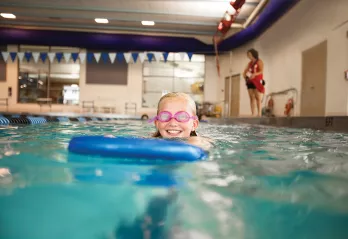12 Facts to Test Your Water Safety IQ

May 9, 2022
- Doing this with children ages 1-4 can reduce the risk of drowning by 88%?
Answer: Swim lessons.
Fact: The Y currently offers swim lessons to everyone 6 months of age and older with a focus on learning important water safety skills first like having permission to swim, floating on your front and back and always swimming with adult supervision (no matter your age - buddy up, buttercup!)
- If you find yourself caught in a rapid current in a river, stream or creek, how should you position your body to reduce risk of injury?
Answer: On your back with your feet forward in the current. If you can put your body into a semi-sitting position (think a v-sit in the river - this is very easy if you are wearing your life jacket)
- The majority of drownings in the United States happen in private pools or other private bodies of water. Name 2 safety measures a homeowner can take to increase the safety of the water on their property.
Answer: Reduce access to the water with fencing or natural features such as heavy hedges around pools and other bodies of water. Remove outer ladders when not in use. Cover the surface of a pool with a safety cover (rated to hold the weight of a person if someone falls in). Personal floatation devices (PFDs) aka lifejackets for none swimmers. Ensure that everyone knows the house rules and no one swims alone or without a water watcher. Make sure the water watcher is a designated person.
- How much of the earth is covered in water?
Answer: 71%
Fact: Planning to avoid the water is not enough. Everyone should be able to access water safety skills to be ready just in case. The YMCA had a national call to teach every man and boy to swim in this country - that call still exists today. Our state is not known for its beaches - but there are plenty of rivers, lakes, and creeks that we have access to.
- What was the first patented lifejacket made out of?
Answer: Cork!
Fact: Did you know there are multiple types of lifejackets or PFDs (personal floatation devices)? A type 1 lifejacket is designed to keep you afloat and tilted slightly backward even if you fall unconscious (out on open water - get this kind!! they are pretty stylish now). A type 2 lifejacket will perform similarly but is designed for conscious wearers.
- CPR is an important skill for everyone to learn, especially is you own a pool or live near an open body of water. What does CPR stand for?
Answer: Cardio Pulmonary Resuscitation
IMPORTANT: 2 keys to remember
- Always call 911 before you begin CPR (if you are acting alone) or designate another person to call 911.
- Compress hands down firmly in the center of the chest at a rate of 100 to 120 compressions per minute (do compressions to the beat of Stayin' Alive by the Bee Gees or Baby Shark)
- Before Michael Phelps took the world by storm, which Olympic swimmer held the record for most gold medals in a single Olympic Games?
Answer: Mark Spitz
- You are at the beach and find yourself in water that is rapidly pulling you into open water away from the shore, what do you do?
Answer: Swim Parallel to the shore until you no longer are being pulled. Then swim into shore.
Fact: Fighting the current and swimming against it will only make you tired putting you at an elevated risk for drowning. Make sure you read all warnings posted at a beach and don't swim during times when there is a high risk for a rip tide.
- What Organization founded the Volunteer National Lifesaving Service in 1912?
Answer: The YMCA.
Fact: Originally the National Lifesaving Service started as a water safety platform with volunteers teaching people what to do in an emergency and how to keep themselves safe before adding water rescues in the mix a few years later.
- Who was the first African - American swimmer to hold a world record?
Answer: Cullen Jones, for the 4 x 100 - meter freestyle relay.
Fact: Before being enrolled in swim lessons Cullen experienced a near drowning event at a water park. His natural affinity for the water quickly became clear once he learned to swim.
- Organized swim lessons began at the Detroit YMCA in 1909 to answer the call of the National YMCA to teach every man and boy how to swim. In one city alone this man taught 800 boys to swim in 4 weeks. Who was that man?
Answer: George Corson.
Fact: George Corson revolutionized swim lessons by introducing a group swim lesson model and teaching beginner swimmers the crawl stroke (freestyle) first instead of breaststroke. His influence lives on in what we teach in swim lessons today.
- What is the correct name for the floating style often known as the "deadmans float"?
Answer: Survival float Or Prone float
Fact: People are naturally more able to float comfortably face down. This is considered a resting position because it requires little energy. When you need to breather you perform a half stroke to lift your head before relaxing down again.
Learn more about water safety and swimming programs at the YMCA of Greater Brandywine.
Locations